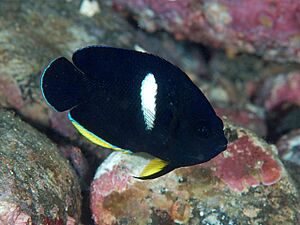Keyhole angelfish facts for kids
Quick facts for kids Keyhole angelfish |
|
|---|---|
 |
|
| Conservation status | |
| Scientific classification | |
| Synonyms | |
|
Holacanthus tibicen Cuvier, 1831 |
The Centropyge tibicen, also known as the keyhole angelfish, is a beautiful marine fish. It's also called the black angelfish or whitespot angelfish. This fish is a type of marine angelfish and lives in the warm waters of the Indo-Pacific region.
Contents
Appearance of the Keyhole Angelfish
The keyhole angelfish is mostly black. Adult fish have a long, black mark on the upper part of their sides. This mark looks a bit like a keyhole! Younger fish start with a white bar, which slowly changes into this black mark as they get older.
Their fins have some cool details too. The fins on their back and belly have a blue line right near the edge. The front part of their belly fins and some of their anal fin are bright yellow. Even their tail fin has a blue line. These fish can grow up to about 19 centimeters (about 7.5 inches) long.
Where They Live
You can find the keyhole angelfish in the Indo-Pacific region. This huge area stretches from the northwest coast of Australia and Christmas Island all the way east to Vanuatu and Tonga. They also live as far north as southern Japan and Taiwan, and south to Lord Howe Island.
Life in the Ocean
Keyhole angelfish usually live in waters between 4 and 35 meters (about 13 to 115 feet) deep. They prefer areas where there's a mix of coral and rocky rubble. You can find them in calm lagoon reefs and also on reefs facing the open ocean.
What They Eat
These angelfish are herbivores, which means they mainly eat plants. Their favorite food is algae, which they graze on from the rocks and corals.
Social Life and Reproduction
Keyhole angelfish live in small groups called harems. A harem usually has about 3 to 7 fish. What's really interesting about them is that they can change their sex! If there's no male in a harem, one of the females can change into a male. This helps the group continue to reproduce.
Naming the Keyhole Angelfish
The keyhole angelfish was first officially described in 1831 by a French scientist named Georges Cuvier. He gave it the name Holocanthus tibicen. The name tibicen means "trumpeter." This name might have come from an earlier Dutch naturalist, François Valentijn, who called a similar fish the "Japonfche Trompetter" in 1726. Later, in 1860, another scientist named Johann Jakob Kaup created the genus Centropyge and chose Cuvier's H. tibicen as the main example for this new group of fish.
Keyhole Angelfish and People
Because of their beautiful colors and interesting behavior, keyhole angelfish are often kept in home aquariums. They are a popular choice for fish enthusiasts.


